Table of Contents
India is navigating a critical juncture in its energy transition, focusing on renewable sources while grappling with the increasing demand for rare earth elements (REEs). Despite being the fifth-largest holder of REEs, India imports about 60% of its rare earths from China due to inadequate domestic extraction technologies.
Kazakhstan: A Strategic Alternative for India
- Kazakhstan, rich in Rare Earth Elements (REEs), is emerging as a promising partner for India to mitigate dependency on China.
- Key aspects of Kazakhstan’s REE industry:
- Hosts 15 of the 17 known rare earth elements.
- Advanced extraction technologies and partnerships with Japan, Germany, the U.S., South Korea, and the European Union.
- Growth in dysprosium production (essential for clean energy) is expected between 2024 and 2029.
- Known as one of the world’s largest producers of tantalum and niobium, critical for nuclear reactors and clean energy.
- Holds a significant role in manufacturing beryllium, scandium, tungsten, and battery materials.
- Extracts strategic minerals like bismuth, selenium, and tellurium and uses imported technologies to produce gallium and indium, crucial for renewable energy.
- Kazakhstan’s President Kassym-Jomart Tokayev has called rare earths the “new oil” of the country’s economy.
India-Kazakhstan Collaboration: Potential and Challenges
- India’s renewable energy pledge at COP29 includes achieving 500 GW of capacity by 2030, requiring rare earths like dysprosium.
- A planned 400% increase in domestic REE mining output over the next decade is insufficient to meet current and future needs.
Challenges
- Lack of necessary extraction technologies in both India and Kazakhstan.
- Connectivity issues between the two nations.
Opportunities
The ‘India-Central Asia Rare Earths Forum,’ proposed during the second India-Central Asia Summit, aims to enhance partnerships through:
- Bilateral training programs.
- Joint mining ventures and shared geological data.
- Private sector investment and sustainable extraction practices.
- Development of a regional REE market to reduce reliance on China.
- India’s engagement with Kazakhstan through the ‘Connect Central Asia’ policy and the International North-South Transport (INSTC) Corridor strengthens the foundation for collaboration.
Strategic Implications
- Diversification through Kazakhstan can help India reduce its reliance on China and strengthen resource security.
- By leveraging Kazakhstan’s advanced technologies and mining potential, India can create a more sustainable and robust supply chain for rare earths.
- A strategic partnership can foster economic growth for both nations while supporting global clean energy goals.


 Indus Water Treaty 1960 Suspended by Ind...
Indus Water Treaty 1960 Suspended by Ind...
 5 Years of SVAMITVA Scheme and Its Benef...
5 Years of SVAMITVA Scheme and Its Benef...
 Places in News for UPSC 2025 for Prelims...
Places in News for UPSC 2025 for Prelims...





















